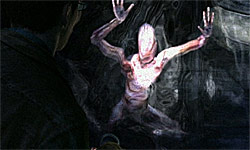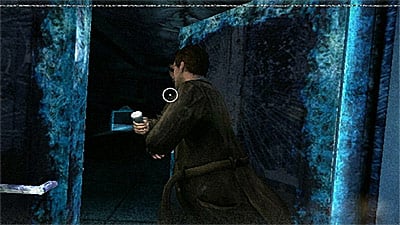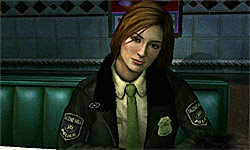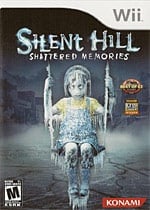In the late 90’s, the 32-bit era gave birth to the survival horror genre. The two main series in the genre that had gamers playing during the day with their lights on were Resident Evil and Silent Hill. Resident Evil shocked players with its jump scares and zombies, while Silent Hill relied on a more psychological kind of terror. Both series are frightening in their own ways, but, personally, I’ve always found Silent Hill to be much more disturbing, and therefore more compelling to play. As a huge fan of the original Silent Hill, I was quite apprehensive about the idea of a “reimagining” of the classic title, especially since it would be on the Wii and implement motion controls into the experience. Thankfully, although the game does have its issues, it is still one of the most interesting and unique Silent Hill experiences to date.

Perhaps the game’s greatest strength is that it doesn’t just attempt to be a visually prettier remake of the original Silent Hill. Instead, besides the basics of it taking place in Silent Hill, revolving around Harry’s search for his missing daughter Cheryl, and using some of the same character names, this is a completely new title. Even so, players will still be in control of Harry who manages to crash his car (doesn’t he always) in the town of Silent Hill. Upon waking up after the accident, Harry notices that Cheryl is gone, as is most of his memory, leaving you to search the town for clues to her whereabouts while also trying to come to grips with his scrambled memories.
Before you get to take control of Harry, you’re first psychologically profiled by the game. You are asked a series of odd questions that shed light on everything from your drinking habits to your sex life. These kinds of mind games are a big part of this title’s experience, even going as far as starting off with a psychological warning as the game boots up stating that the game is playing you as much as you are playing it. Intermittently, throughout the title, you’ll find yourself sitting across a desk from a therapist. He’ll often question you, discuss various things that may pertain to what is currently going on in your adventure, and have you do things such as listing your perfect day of high school classes or even coloring in a picture of your house and family. Many of the questions he asks and the tasks he has you perform will actually shape your experience, adding a ton of replayability when done differently. Some examples of the changes that these things can cause may be as arbitrary as changing the color of your old house to more drastic and important differences such as determining the character’s you’ll meet or the way some characters will act. This aspect of the game is truly novel and interesting, making you want to play through the game several times just to see all of the possible differences.

While exploring Silent Hill, you’ll need to make use of your cell phone. This device is pretty well integrated into the experience and can be used to save the game, as your map, to hear incoming calls and messages, and even as a camera. Throughout the game you’ll find apparitions that need to be photographed, discarded mementos from someone else’s life that need to be collected, and random items of interest that will all result in either voice or text messages being received. These voice messages can be really interesting as well as quite unsettling, and will come through the speaker on your Wii Remote, making them sound even more distorted and otherworldly. The map function of your phone can also be somewhat useful, although much of the game’s exploration is quite linear in nature, usually only involving one path/door to take.
Players will control Harry’s movements with the analog stick while aiming a flashlight and turning by pointing the Wii Remote. This works well when exploring the ins and outs of the dark and snow-covered town, pulling you further into the experience as you shine light onto whatever you wish to illuminate. The lighting effects caused by the flashlight are quite good, accurately creating shadows that change in size and positioning depending on how you’re pointing it and where you’re located. The shadows cast by your flashlight really add to the creepy vibe of the game and can occasionally cause a scare or two by themselves.

Pointing the flashlight works well, and there are quite a few other interesting uses of motion controls to be found in Shattered Memories. You’ll encounter many puzzles while trying to find your daughter, most of which make good use of the motion controls. Most of the puzzles you’ll find will require you to pinch or hold an object, which is handled by pinching the Wii Remote by pressing the A and B buttons simultaneously, in order to be able to maneuver it. A good example of this is a window that you’ll need to open in order to get into a high school. You’ll need to grab hold of four nails, pull them out using the motion controls, and then grab the window and swing up in order to open it.

Shattered Memories gets many things right in the story and gameplay departments during the majority of the game, though it manages to get just as much wrong in the nightmare segments of the game. Whereas in the original Silent Hill, when things got rusty and blood-covered during these portions, in Shattered Memories everything freezes over and the game’s monsters come out to play. Since there’s no combat in the game, you’re reduced to simply trying to run away from these creatures in a desperate attempt to find the exit point for the nightmare. Standing in your way are the monsters that will latch onto you from in front, behind, to the left, or to the right. Once they’re attached, you’ll be unable to move until you shake the Wii Remote and Nunchuk in the correct direction to dislodge them. The responsiveness of the controls here is quite lacking, as it can take several over-exaggerated gestures before the game will actually pick up on it.
To help out somewhat, blue lines will outline doors and ledges that can be used, giving you a quick visual reference for a place to run to. However, while the explorative parts of the game were rather linear, these segments are full of multiple doors and paths to get lost in and confused. To make matters worse, pulling out your cell phone to reference your map is virtually suicide, as you are forced to walk when your cell phone is out. You are also unable to use your cell when hiding in closets or under beds/tables, when trying to get a brief respite from the chase to regain some composure or to lose trailing monsters. Even if you do hide in an attempt to lose some of your pursuers, they’ll never actually go away. They just keep walking around where you’ve hidden until one eventually pulls you from your hiding place and the chase begins again. What you’re reduced to is a frantic, directionless running spree full of while constantly being tackled by enemies and hindered by shoddy motion detection until you either find the correct destination by random chance or the monsters eventually take you down and you’re forced to start over again from the beginning.
The nightmare segments of this title, truly, are unnecessarily frustrating, and serve as the only major blemish on an otherwise enjoyable game. Unfortunately, there’s no way to bypass these infuriating segments and memorization isn’t always a guarantee for success, so if you want to enjoy the rest of the title, you’ll likely just have to retry them again and again until you get lucky. Still, the game is good enough that it is worth slogging through these nightmare segments in order to get the full experience. The moody visuals and the soundtrack from renowned composer Akira Yamaoka are great and exactly what you’d expect from a Silent Hill title. The psychological testing bits are also quite interesting and add a ton of replayability and variety to the game. If only the good aspects weren’t constantly polluted by the aggravating nightmare portions, Shattered Memories might have been one of the best Silent Hill’s yet.
RATING OUT OF 5 RATING DESCRIPTION 4.2 Graphics
Shattered Memories really does look great for a Wii game (obligatory qualifier) with well detailed character models and some great lighting effects. 3.7 Control
While generally things work well, with some excellent uses of motion control throughout, they tend to feel much less reliable during the nightmare segments in the game when you need them to work accurately. 4.5 Music / Sound FX / Voice Acting
Here you’ll find some respectable voice acting and haunting sound effects as well as another fantastic soundtrack by Akira Yamaoka. 3.7
Play Value
The game is a little short but makes up for it by adding a ton of variety due to the changes that will occur from answering differently during your psychological profiling. If only you could just skip past all the completely infuriating nightmare segments in the game and simply enjoy the great game that surrounds them.
3.8 Overall Rating – Good
Not an average. See Rating legend above for a final score breakdown.
Game Features:
